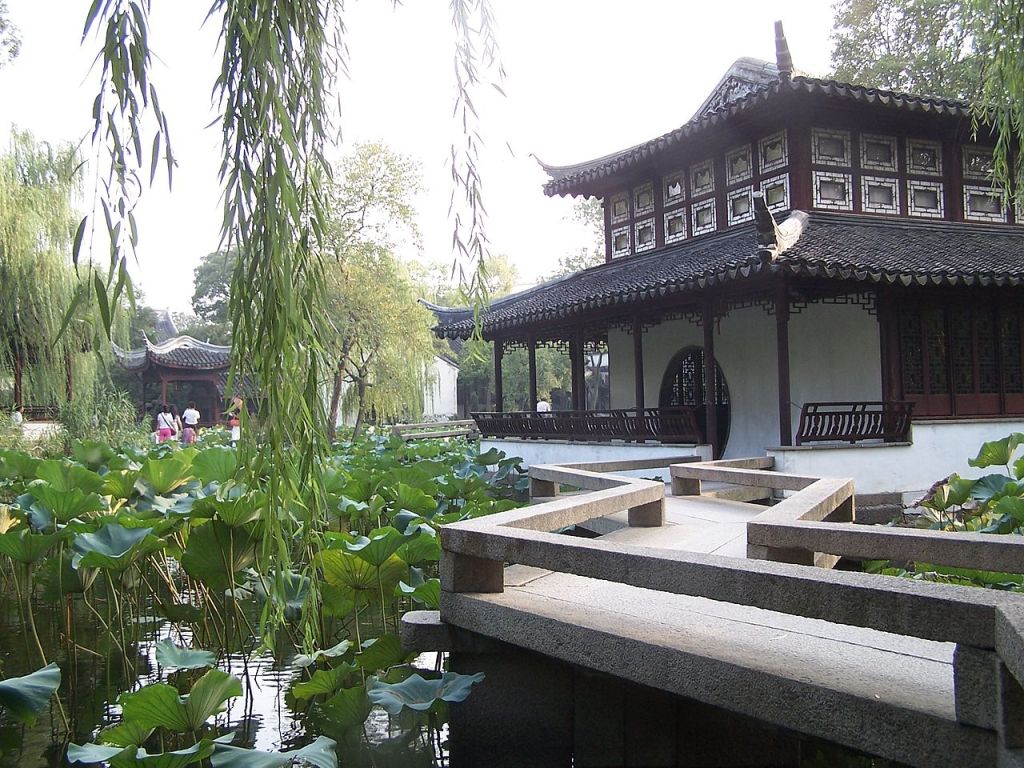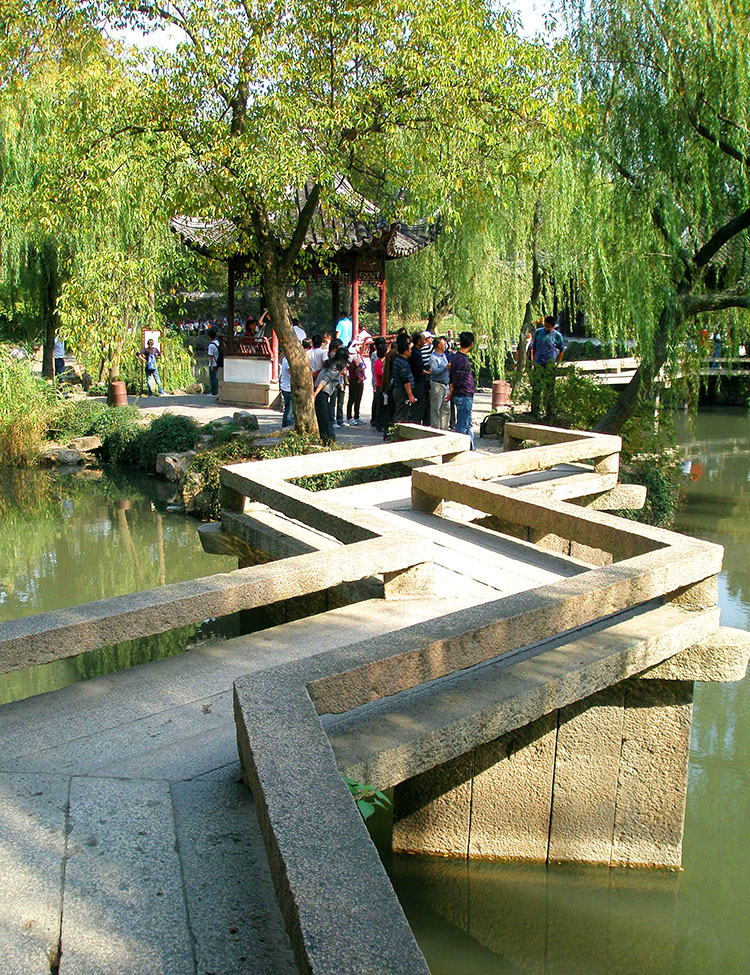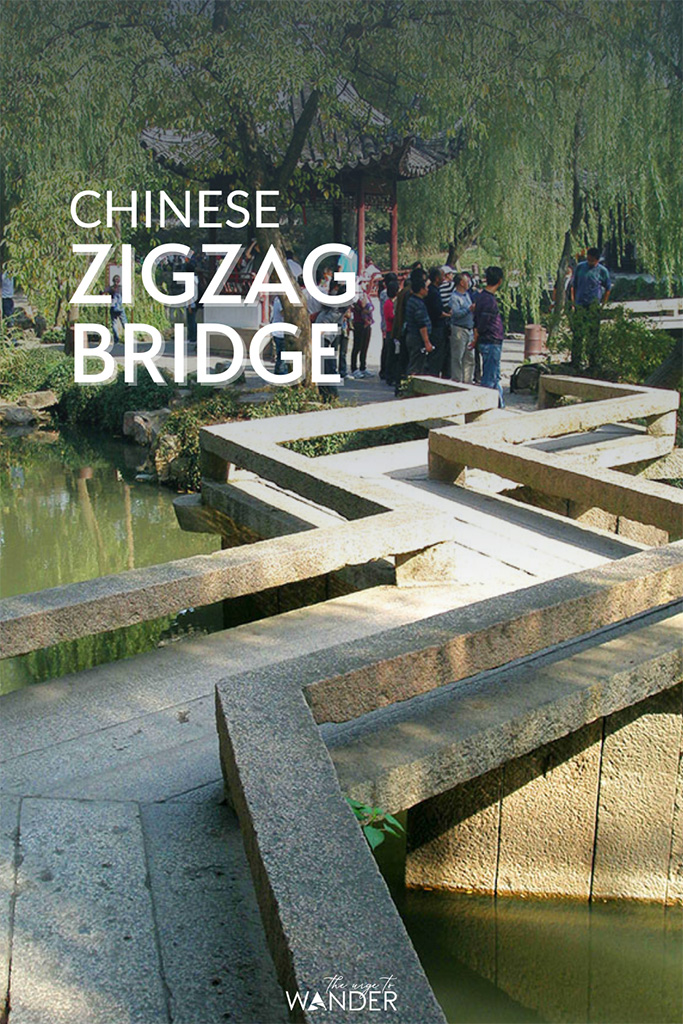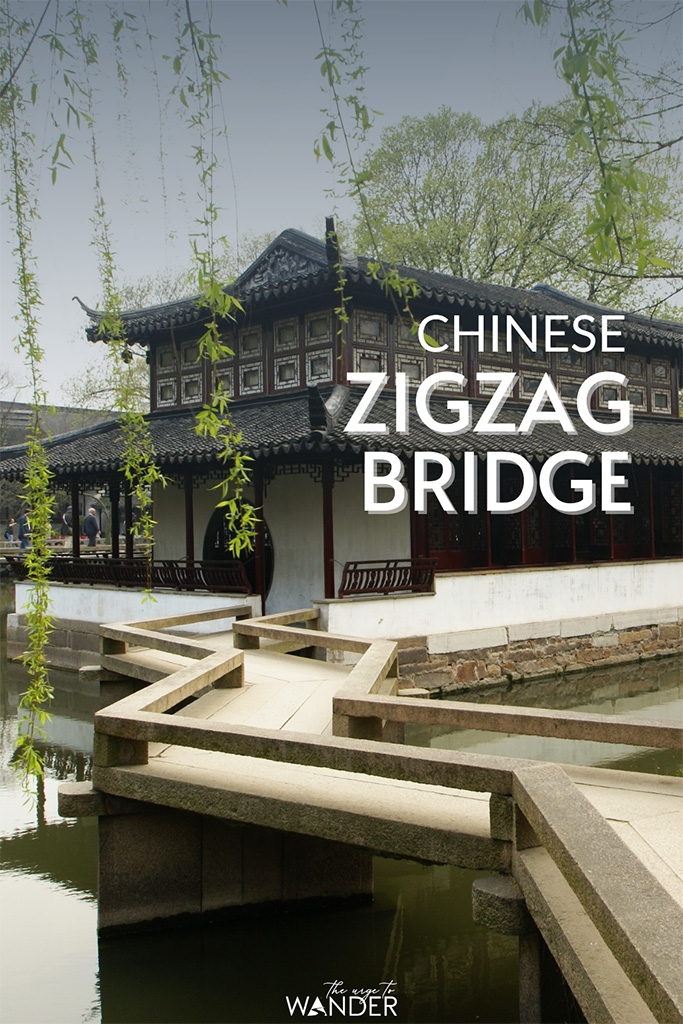
The zig-zag bridge – also referred to as the nine-turn bridge – is a common feature in classical Chinese gardens.
According to local lore (and tourist guides!) zigzag bridges and paths are said to confound evil spirits that can only follow a straight path for whatever reason.
In actual fact, these bridges are mostly decorative features based on the Zen principle of mindfulness. Their non linear construction is designed to force one’s attention on the HERE and NOW and to slow one’s pace to take pleasure in the skilfully cultivated landscape around.

Do check out my post on the canals and gardens of Suzhou. And while you are there you might want to spare a moment to admire the genius of I M Pei.
Happy travels…no matter where life takes you.


Extraordinarily beautiful!. I love the design…you always impart something new…thanks Madhu!
Here in San Francisco, there is an enormous Chinese ( politically described here as the “Asian Americans”), population. They were amongst the earliest settlers on US soil. I have been driven down a SF Street known as the “Zig Zag Street!” Would that connect to a homesick Chinese road planner….far away from his homeland? 🙂
Wonderful 🙂 I would never have guessed the concept behind the design.
Fantastic entry for the zigzag challenge!
I am always intrigued by the similarities AND the differences between Chinese gardens and their descendants, Japanese gardens. I loved this view of Suzhou, probably the one place in China I am sorry to have missed. And I loved your juxtaposition of I.M. Pei’s Museum in his home town. Now I am going to look up I.M. Pei’s Museum in Japan that I muzzily remember having seen a great deal about, and being totally struck by. Your posts are so extraordinary, you explain things so clearly and link together things seemingly disparate but that then you connect.
In your debt!
Thank you very much Judy! I am grateful to you for reading and for your generous appreciation always. Comments like your make the effort that goes into this blog worthwhile 🙂
I was sorry I missed Pei’s Miho museum near Kyoto on my visit. It looks lovelier than the one in Suzhou.
This is really interesting, Madhu. I like the idea very much, and also the title of, “Humble Administrator.” 🙂 The graceful Willow trees make a beautiful backdrop to the zigzag bridge, and also remind me of a house we once had on the bank of river which was edged with these lovely trees.
Suzhou gardens all have captivating names Sylvia….Lingering Garden, Lion grove Garden, Mountain Villa with Embracing Beauty!!! 🙂
Your old house by the willow lined river sounds lovely! Do you have photos of it on your blog?
Wonderful names, Madhu. No, I’m afraid the house by the river was so long ago. I wouldn’t know where to start looking for the photos. I think there were very few. 😦
hmmmm no wonder i could not cross .. it thought i was the devil..
that is a beautiful pic and a good idea for sure
🙂 Thank you Bikramjit.
I love the intricacy of Chinese gardens. They are so lovely!
Me too Nicole. The region around Shanghai seems to have the nicest ones.
I like the idea of slowing your pace to really focus on what’s around you. If those twists and turns weren’t there, how easy would it be to just zip thru and not see the beauty nature offers. Lovely photo, Madhu.
What a clever way to make people slow down to soak in the beauty around them! Madhu, I nominated you for the 5 destinations I’d go back to challenge. The details are on my post http://kanwalkwilltravel.com/2014/08/03/top-5-destinations-id-return-to/. Would be great if you decide to participate 🙂
Thank you Kan. Can’t seem to make up my mind about the destinations I want to return to 🙂
This is fabulous I love this garden and the bridge.
There are a half dozen such gardens in this little town Valentine! And half of those are UNESCO sites!! 🙂
Great choice for the challenge Madhu. Thanks for the explanation for the use of non-linear planning.
Thank you for reading Luann. Have a happy Wednesday! 🙂
You too Madhu! 🙂
I love the whole idea of this. Much more interesting than a straightaway too!
Far more aesthetic isn’t it? Thank you Margie, a pleasure to see you here.
Nice shot, Madhu!
Thank you Stefano.
Interesting concept with the pictures depicting the theme so well. Thanks Madhu 🙂
Thank you very much Dilip.
Yes I learned that from my Singapore working days. It’s comforting to know devils can’t zig zag isn’t it? 🙂
Very! 🙂 Thank you for stopping by Ian.
Pei’s designs are extraordinary, Madhu. I think I’ll just have a little canalside wander with you first 🙂
Hope you enjoyed it Jo. The images aren’t the best quality, but I am rather fond of my earliest China and Egypt posts 🙂
I presume this is linked to the WP challenge, Madhu? I didn’t notice the link as I wandered 🙂
It is, the link is right at the beginning.
So absorbed in your post, you see! (and I didn’t know what this week’s theme was till I saw it elsewhere 🙂 )
🙂
I’m pretty sure I visited the same bridge when I was in Suzhou! The zen explanation makes sense to me. Lovely pic!
-Amanda at http://teachingwanderlust.com/
It certainly does, compared to the spirit story 🙂 Appreciate your visit and comment Isbergamanda.
Absolutely perfect Madhu, taking the mindful path works for me 🙂
Thanks, me too Gilly 🙂
Such an interesting post!!
Glad you think so Divz. Thank you for stopping by to comment.
That’s a GREAT bridge, Madhu 🙂
It is special Marianne. Seems distinctive to us, but not uncommon in China and Japan.
Looks like a beautiful place to be too!
It is Indah. There are several other gardens even more beautiful. And quite a few of those are UNESCO heritage sites.
ooops…here is my blog.if you wish to visit markets with me. Do check the Singapore Wet marketon http://www.walktomarket.wordpress.com
Would love to market hop with you Veena. Thank you for your visit and comment.
Living in Singapore for many years, I still did not know the history behind the zig zag bridges . Nice to stop by your post. I too love to travel and write my experiences.
What a beautiful bridge and it’s so lovely there Madhu! You’ve captured the beauty so well. Great interpretation for the challenge. 😀
Thank you so much Sonel. Have a great weekend 🙂
Thanks hon. I sure did and hope yours was good as well. 😀
Zen, and so like life … lovely under the willows, Madhu. 🙂
By the way – where’s your new background shot?
Thanks Meredith. My background is back on popular demand! 🙂 Bama pointed out to me that the old one was showing cropped on his screen, which I assume is wider than most. So I put in a temporary background until I could process a copy of the right resolution.
You have been rather quiet. Hope your winter is treating you well.
I see! I love that old carriage rickshaw, and the shot is just right for your blog – it’s just that the ‘temporary’ shot was so interesting I wanted to see more, know more … 🙂
I have been a bit absent, haven’t I? I am trying to keep up with everyone, though I’m struggling with posting and chatting. This move back has been challenging all around and I haven’t really established a happy routine, especially in this winter … I’m well, though, and that’s the most important thing! When are you off to Africa?
Gosh! I should watch out for these… I’m sure to land in the water… Zen in quite another fashion.
Hmm… I wonder what the Sufi thinks about this?
Fascinating! … and why do spirits walk the straight line (shortest path from point A to B)? Pretty smart of them, I’d say!
On the contrary, I think those spirits must not be too smart, as Juliann puts it above, to be confounded so easily from their chase 😀 And you my dear Meenakshi, seem like a very mindful person…you wouldn’t be able to write such profound verse otherwise! 🙂
very true, informative and important. Great presentation!
Happy you think so. Thank you Mihrank.
mindfulness is a skill we all need. Imagine all the things we miss by rushing to and fro. 🙂
True, and these gardens have so many cultivated view points that you wouldn’t want to miss at all! 🙂 Have a fun weekend Imelda.
Truly, it’s a marvelous bring, and it shows that concrete can be used effectively aesthetically.
It is. And I am a fan of stark concrete slabs in landscape architecture too Sally. Their simplicity is the perfect contrast to the colour and fluid shapes of the natural elements.
We have a zigzag in one of our gardens here in San Diego but for the life of me I can’t remember where. I remember zigzagging across it, though, and thinking how cool it was.
Could it have been in the Japanese garden? They are lovely features and it is fun to weave through them, when they aren’t crawling with people 🙂
Yeah, but I just can’t remember where. If I could remember where, I could find the pictures.
I’d forgotten this idea of zigzagging or adding a step in China to thwart evil spirits. It’s one of those ideas that tickle me. Evil spirits must not be too bright. 🙂
Obviously not Juliann! 😀
I LOVE classical Chinese Gardens. Yuyuan in Shanghai is a great example, but lots of places in Chengdu, too, like Wenshu Park.
I posted a link to the Yuyuan above, but the zigzag bridge there was heaving with people, so I didn’t get a good enough shot. The Suzhou gardens are gorgeous with several on the UNESCO list.
Interesting concept, indeed. It would provide a challenge to cyclists.or the inebriated!
Hehehe perhaps it is the imbibing of ‘spirits’ they are trying to discourage Col.!!! 😀
Great choice for this challenge 🙂
Thank you. I am surprised there aren’t more such bridges from China actually!
The shape is contrary to what I would have expected in a Chinese or oriental garden. It’s modernistic and yet appealing. Have a great weekend, Madhu.
There was one such bridge in every garden we visited on that trip Lynne! Some have ornate railings, but most are stark and simple like this one. A great weekend to you too 🙂